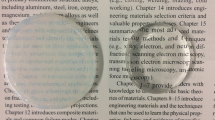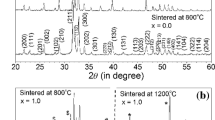Abstract
Silicon complexes in silicon doped calcium phosphate bioceramics have been studied using 29Si magic angle spinning nuclear magnetic resonance spectroscopy with the objective of identifying the charge compensation mechanisms of silicon dopants. Three different materials have been studied: a multiphase material composed predominantly of a silicon stabilized α-tricalcium phosphate (α-TCP) phase plus a hydroxyapatite (HA) phase, a single phase Si-HA material and a single phase silicon stabilized α-TCP material. NMR results showed that in all three materials the silicon dopants formed Q1 structures in which two silicate tetrahedra share an oxygen, creating an oxygen vacancy which compensated the substitution of two silicon for phosphorus. This finding may explain the phase evolution previously found where silicon stabilized α-TCP is found at low temperature after sintering.




Similar content being viewed by others
References
Bohner M. Calcium orthophosphates in medicine: from ceramics to calcium phosphate cements. Injury. 2000;31:D37–47.
Vallet-Regí M, González-Calbet JM. Calcium phosphates as substitution of bone tissues. Prog Solid State Chem. 2004;32:1–31.
Hench L. Bioceramics: from concept to clinic. J Am Ceram Soc. 1991;74:1487–510.
Ducheyne P, Radin S, King L. The effect of calcium-phosphate ceramic composition and structure on in vitro behaviour. J Biomed Mater Res. 1993;27:25–34.
Porter AE, Patel N, Skepper JN, Best SM, Bonfield W. Comparison of in vivo dissolution processes in hydroxyapatite and Si-substituted hydroxyapatite bioceramics. Biomaterials. 2003;24:4609–20.
Patel N, Gibson IR, Hing KA, Best SM, Revell PA, Bonfield W. A comparative study on the in vivo behaviour of hydroxyapatite and Si-substituted hydroxyapatite granules. J Mater Sci: Mater Med. 2002;13:1199–206.
Carlisle EM. Silicon: an essential element for the chick. Science. 1972;178:619–21.
Carlisle EM. Silicon: a possible factor in bone calcification. Science. 1970;167:279–80.
Qiu Q, Vincent P, Lowenberg B, Sayer M, Davies JE. Bone growth on sol–gel calcium phosphate thin films in vitro. Cells Mater. 1993;3:351–60.
Davies JE, Shapiro G, Lowenberg B. Osteoclastic resorption of calcium phosphate ceramic thin films. Cells Mater. 1993;3:245–56.
Langstaff S, Sayer M, Smith TJN, Pugh SM, Hesp SAM, Thompson WT. Resorbable bioceramics based on stabilized calcium phosphates. Part I. Rational design, sample preparation and material characterization. Biomaterials. 1999;20:1727–41.
Langstaff S, Sayer M, Smith TJN, Pugh SM. Resorbable bioceramics based on stabilized calcium phosphates. Part II. Evaluation of biological response. Biomaterials. 2001;22:135–50.
Pietak AM. The role of silicon in the bioactivity of Skelite™ bioceramic. A material and biological characterization of silicon α-tricalcium phosphate based ceramics. Master’s thesis, Queen’s University; 2007.
Astala R, Calderin L, Yin X, Stott MJ. Ab initio simulation of Si-doped hydroxyapatite. Chem Mater. 2006;18:413–22.
Yin X, Stott MJ. Theoretical insights into bone grafting silicon-stabilized α-tricalcium phosphate. J Chem Phys. 2005;122(024709-1).
Kusachi I. The structure of rankinite. Mineral J. 1975;8:38–47.
Saburi S, Kusachi I, Henmi C, Kawahara A, Henmi K, Kawada I. Refinement of the structure of rankinite. Mineral J. 1976;8:240–6.
Midgley CM. The crystal structure of β dicalcium silicate. Acta Crystallogr. 1952;5:307–12.
Jost KH, Ziemer B, Seydel R. Redetermination of the structure of β-dicalcium silicate. Acta Crystallogr B 1977;33:1696–700.
Sayer M, Stratilatov AD, Reid JW, Calderin L, Stott MJ, Yin X, et al. Structure and composition of silicon-stabilized tricalcium phosphate. Biomaterials. 2003;24:369–82.
Reid JW, Tuck L, Sayer M, Fargo K, Hendry JA. Synthesis and characterization of single-phase silicon substituted α-tricalcium phosphate. Biomaterials. 2006;27:2916–25.
McLean DA. Osteoblast response on silicon doped calcium phosphate biomaterials. Master’s thesis, Queen’s University; 2007.
Cabot Corporation. 500 Commerce Dr., Aurora, IL. http://www.cabot-corp.com.
Cambridge Isotope Laboratories Inc. 50 Frontage Road, Andover, MA. http://www.isotope.com.
Reid JW, Fargo K, Hendry JA, Sayer M. The influence of trace magnesium content on the phase composition of silicon-stabilized calcium phosphate powders. Mater Lett. 2007;61:3851–4.
Reid JW, Hendry JA. Rapid, accurate phase quantification of multiphase calcium phosphate materials using Rietveld refinement. J Appl Crystallogr. 2006;39:536–43.
Mathew M, Schroeder LW, Dickens B, Brown WE. The crystal structure of α-Ca3(PO4)2. Acta Crystallogr B. 1977;33:1325–33.
Sudarsanan K, Young RA. Significant precision in crystal structural details: holly springs hydroxyapatite. Acta Crystallogr B. 1968;25:1534–43.
National Institute of Standards and Technology. Standard reference material 2910. Gaithersburg, MD; 2003.
SGS Minerals Service. 185 Concession St. Lakefield, ON. http://www.met.sgs.com.
Acorn NMR Inc. 7670 Las Positas Rd., Livermore, CA. http://www.acornnmr.com.
Mägi M, Lippmaa E, Samoson A, Engelhardt G, Grimmer AR. Solid-state high-resolution silicon-29 Chemical shifts in silicates. J Phys Chem. 1984;88:1518–22.
Engelhardt G, Michel D. High-resolution solid-state NMR of silicates and zeolites. John Wiley & Sons; 1987.
Stebbins JF. Mineral physics & crystallography. A handbook of physical constants, vol. 2, chapter 14. American Geophysical Union; 1995.
MacKenzie KJD, Smith ME. Multinuclear solid-state NMR of inorganic materials. Oxford: Elsevier Science; 2002.
Sherriff BL, Grundy HD. Calculations of 29Si MAS NMR chemical shift from silicate mineral structure. Nature. 1988;332:819–22.
Sherriff BL, Grundy HD, Hartman JS. The relationship between 29Si MAS NMR chemical shift and silicate mineral structure. Eur J Mineral. 1991;3:751–68.
Malik KMA, Jeffery JW. A re-investigation of the structure of afwillite. Acta Crystallogr B. 1976;32:475–80.
Gibson IR, Best SM, Bonfield W. Chemical characterization of silicon-substituted hydroxyapatite. J Biomed Mater Res. 1999;44:422–8.
Leventouri Th, Bunaciu CE, Perdikatsis V. Neutron powder diffraction studies of silicon-substituted hydroxyapatite. Biomaterials. 2003;24:4205–11.
Tang XL, Xiao XF, Liu RF. Structural characterization of silicon-substituted hydroxyapatite synthesized by a hydrothermal method. Mater Lett. 2005;59:3841–6.
Arcos D, Carvajal JR, Vallet-Regí M. The effect of the silicon incorporation on the hydroxylapatite structure. A neutron diffraction study. Solid State Sci. 2004;6:987–94.
Tuck LE. The phase evolution and microstructure of silicon doped tricalcium phosphate. Master’s thesis, Queen’s University; 2005.
Hesse KF. Refinement of the crystal structure of wollastonite-2m (parawollastonite). Zeitschrift für Kristallographie. 1984;168:93–8.
Acknowledgements
Work supported by the NSERC of Canada and Millenium Biologix Inc. Many discussions with Joel Reid are gratefully acknowledged.
Author information
Authors and Affiliations
Corresponding author
Rights and permissions
About this article
Cite this article
Gillespie, P., Wu, G., Sayer, M. et al. Si complexes in calcium phosphate biomaterials. J Mater Sci: Mater Med 21, 99–108 (2010). https://doi.org/10.1007/s10856-009-3852-8
Received:
Accepted:
Published:
Issue Date:
DOI: https://doi.org/10.1007/s10856-009-3852-8




